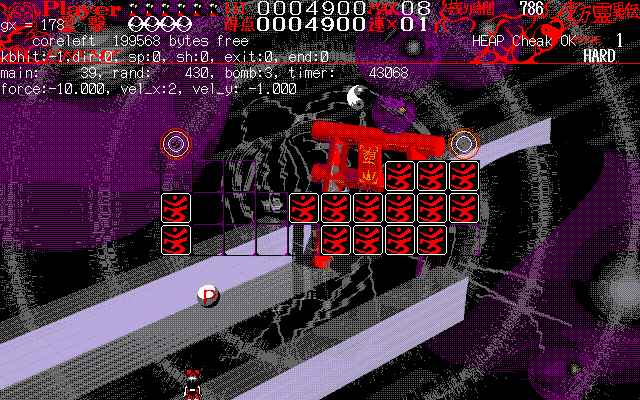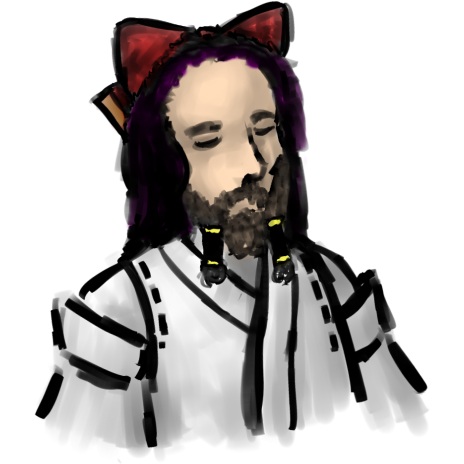- 📝 Posted:
- 🚚 Summary of:
- P0096, P0097, P0098
- ⌨ Commits:
8ddb778...8283c5e,8283c5e...600f036,600f036...ad06748- 💰 Funded by:
- Ember2528, Yanga
- 🏷 Tags:
So, let's finally look at some TH01 gameplay structures! The obvious
choices here are player shots and pellets, which are conveniently located
in the last code segment. Covering these would therefore also help in
transferring some first bits of data in REIIDEN.EXE from ASM
land to C land. (Splitting the data segment would still be quite
annoying.) Player shots are immediately at the beginning…
…but wait, these are drawn as transparent sprites loaded from .PTN files.
Guess we first have to spend a push on
📝 Part 2 of this format.
Hm, 4 functions for alpha-masked blitting and unblitting of both 16×16 and
32×32 .PTN sprites that align the X coordinate to a multiple of 8
(remember, the PC-98 uses a
planar
VRAM memory layout, where 8 pixels correspond to a byte), but only one
function that supports unaligned blitting to any X coordinate, and only
for 16×16 sprites? Which is only called twice? And doesn't come with a
corresponding unblitting function? ![]()
Yeah, "unblitting". TH01 isn't
double-buffered,
and uses the PC-98's second VRAM page exclusively to store a stage's
background and static sprites. Since the PC-98 has no hardware sprites,
all you can do is write pixels into VRAM, and any animated sprite needs to
be manually removed from VRAM at the beginning of each frame. Not using
double-buffering theoretically allows TH01 to simply copy back all 128 KB
of VRAM once per frame to do this. ![]() But that
would be pretty wasteful, so TH01 just looks at all animated sprites, and
selectively copies only their occupied pixels from the second to the first
VRAM page.
But that
would be pretty wasteful, so TH01 just looks at all animated sprites, and
selectively copies only their occupied pixels from the second to the first
VRAM page.
Alright, player shot class methods… oh, wait, the collision functions
directly act on the Yin-Yang Orb, so we first have to spend a push on
that one. And that's where the impression we got from the .PTN
functions is confirmed: The orb is, in fact, only ever displayed at
byte-aligned X coordinates, divisible by 8. It's only thanks to the
constant spinning that its movement appears at least somewhat
smooth.
This is purely a rendering issue; internally, its position is
tracked at pixel precision. Sadly, smooth orb rendering at any unaligned X
coordinate wouldn't be that trivial of a mod, because well, the
necessary functions for unaligned blitting and unblitting of 32×32 sprites
don't exist in TH01's code. Then again, there's so much potential for
optimization in this code, so it might be very possible to squeeze those
additional two functions into the same C++ translation unit, even without
position independence…
More importantly though, this was the right time to decompile the core
functions controlling the orb physics – probably the highlight in these
three pushes for most people.
Well, "physics". The X velocity is restricted to the 5 discrete states of
-8, -4, 0, 4, and 8, and gravity is applied by simply adding 1 to the Y
velocity every 5 frames ![]() No wonder that this can
easily lead to situations in which the orb infinitely bounces from the
ground.
No wonder that this can
easily lead to situations in which the orb infinitely bounces from the
ground.
At least fangame authors now have
a
reference of how ZUN did it originally, because really, this bad
approximation of physics had to have been written that way on purpose. But
hey, it uses 64-bit floating-point variables! ![]()
…sometimes at least, and quite randomly. This was also where I had to
learn about Turbo C++'s floating-point code generation, and how rigorously
it defines the order of instructions when mixing double and
float variables in arithmetic or conditional expressions.
This meant that I could only get ZUN's original instruction order by using
literal constants instead of variables, which is impossible right now
without somehow splitting the data segment. In the end, I had to resort to
spelling out ⅔ of one function, and one conditional branch of another, in
inline ASM. 😕 If ZUN had just written 16.0 instead of
16.0f there, I would have saved quite some hours of my life
trying to decompile this correctly…
To sort of make up for the slowdown in progress, here's the TH01 orb
physics debug mod I made to properly understand them. Edit
(2022-07-12): This mod is outdated,
📝 the current version is here!
2020-06-13-TH01OrbPhysicsDebug.zip
To use it, simply replace REIIDEN.EXE, and run the game
in debug mode, via game d on the DOS prompt.
Its code might also serve as an example of how to achieve this sort of
thing without position independence.

Alright, now it's time for player shots though. Yeah, sure, they don't move horizontally, so it's not too bad that those are also always rendered at byte-aligned positions. But, uh… why does this code only use the 16×16 alpha-masked unblitting function for decaying shots, and just sloppily unblits an entire 16×16 square everywhere else?
The worst part though: Unblitting, moving, and rendering player shots
is done in a single function, in that order. And that's exactly where
TH01's sprite flickering comes from. Since different types of sprites are
free to overlap each other, you'd have to first unblit all types, then
move all types, and then render all types, as done in later
PC-98 Touhou games. If you do these three steps per-type instead, you
will unblit sprites of other types that have been rendered before… and
therefore end up with flicker.
Oh, and finally, ZUN also added an additional sloppy 16×16 square unblit
call if a shot collides with a pellet or a boss, for some
guaranteed flicker. Sigh.
And that's ⅓ of all ZUN code in TH01 decompiled! Next up: Pellets!
